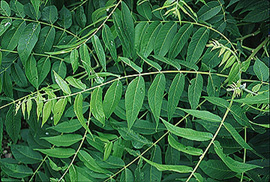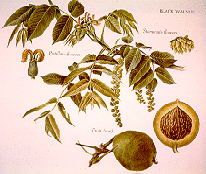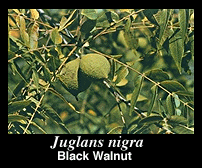Juglans nigra
 Habitat:
Fertile soils in mixed hardwood forests. Also grows well in pastures, meadows, and slopes.
Habitat:
Fertile soils in mixed hardwood forests. Also grows well in pastures, meadows, and slopes.
Characteristics: A major characteristic of this tree is its deeply-furrowed, black bark. Trees range in height from 70-150 feet and have a diameter of 2-4 feet. The compound leaves are between 1 and 2 feet long. This tree is prized for its beautiful wood and the tasty nuts which are avidly harvested in the autumn.
Walnut is unquetionably the finest wood in the world. Our forefathers sought it out and used it lavishly in their homes, barns and fences. The warm brown wood finishes beautifully. It is easy to work, yet durable. It shrinks and swells less than any other wood, which makes it valuable to cabinet makers and gunsmiths alike.
 Practically everyone recognizes a walnut tree when the nuts are on it. Their distinct shape,
pattern and smell are hard to miss. The stain the hulls leave on your skin when you hull walnuts is
hard to get off; pioneers used this to dye their cloth. There are other distinctive characteristics
to identify the tree in other seasons and at ages when it is too young to bear fruit. A sure method
is to cut through a twig at an angle and check the pith. This pith is chambered--somewhat like a
honeycomb. Only black walnut and butternut--a close relative--have pith like this. Walnut pith is
brown and butternut is buff colored. The rather large, horse-faced leaf scars on the twigs, the
large naked buds (no scales cover the embryonic leaves), and the smell of the bark and twigs are
other easy ways to identify it.
Practically everyone recognizes a walnut tree when the nuts are on it. Their distinct shape,
pattern and smell are hard to miss. The stain the hulls leave on your skin when you hull walnuts is
hard to get off; pioneers used this to dye their cloth. There are other distinctive characteristics
to identify the tree in other seasons and at ages when it is too young to bear fruit. A sure method
is to cut through a twig at an angle and check the pith. This pith is chambered--somewhat like a
honeycomb. Only black walnut and butternut--a close relative--have pith like this. Walnut pith is
brown and butternut is buff colored. The rather large, horse-faced leaf scars on the twigs, the
large naked buds (no scales cover the embryonic leaves), and the smell of the bark and twigs are
other easy ways to identify it.
High quality logs are made into veneer. Slices of wood 1/28th of an inch thick are glued to cheaper woods to make it econimically possible for all of us to buy walnut furniture and paneling. Demand far exceeds supply. We use both veneered and solid in our finest furniture. Its strength, stability and beauty make it unexcelled for gunstocks, too. Hickories and pecans are first cousins (botanically) to walnut.
Walnut grows in a variety of soils. However, it grows best on the deep, well-drained soils of north Missouri and on alluvial soils in the south. Usually it occurs as scattered trees or in small groves. Strangely, walnut roots transmit a growth-inhibiting chemical which keeps many other trees and plants and even its own kind from growing near it. Blue grass, however, thrives in the light shade of walnut.
 It should be enough
to have a tree with superb wood. Walnut has a double value, though, over a million dollars is paid
each year for the nuts. The richly flavord nut meats are used by bakers, candy and ice cream
makers. The uses go even further. The hard shells are used as ornaments, and pulverized, they ares
used to drill oil wells, clean jet engines and to make activated carbon (a type of industrial
charcoal used in a variety of ways). During World War II, gas mask filters were made from this
activated carbon. Wildlife loves the walnut, too.
It should be enough
to have a tree with superb wood. Walnut has a double value, though, over a million dollars is paid
each year for the nuts. The richly flavord nut meats are used by bakers, candy and ice cream
makers. The uses go even further. The hard shells are used as ornaments, and pulverized, they ares
used to drill oil wells, clean jet engines and to make activated carbon (a type of industrial
charcoal used in a variety of ways). During World War II, gas mask filters were made from this
activated carbon. Wildlife loves the walnut, too.
Leaves are alternate compound with more than 11 leaflets.
The black walnut is one of our best known and most valuable trees. It is a large, straight-stemmed timber tree with an open crown. When grown in the open it is a short-trunked, low-branching, wide-spreading tree. Widely planted for its nuts, lumber and for ornamental purposes, it is found over the eastern United States as far west as Nebraska, Kansas and Texas. Growing chiefly along bottomlands, in coves and on lower slopes, it prefers a deep, rich, moist but well-drained soil.
 The tree has large, pinnately compound leaves, 12 to 24 inches long with 15 to 23
leaflets. The leaf stems are covered with fine hairs, but are smoother than butternut. The leaflets are 2-1/2 to 3 inches long, yellowish green in color,
tapering at the end and toothed along the margin.
The tree has large, pinnately compound leaves, 12 to 24 inches long with 15 to 23
leaflets. The leaf stems are covered with fine hairs, but are smoother than butternut. The leaflets are 2-1/2 to 3 inches long, yellowish green in color,
tapering at the end and toothed along the margin.
The twigs are brownish, stout, blunt and with prominent leaf scars. The pith is cream colored and chambered, dividing into thin plates or segments.
The fruit is a large, rounded, brownish black nut with a hard, thick, finely ridged shell enclosing a rich, oily kernel. The kernel is edible and highly nutritious. The nut is enclosed in a solid, non-splitting husk, and is borne on the tree singly or in pairs.
The thick bark is dark brown in color and divided by deep fissures into rounded ridges. It has a chocolate brown under-color when broken from the tree.
![]()